How to use toRef and toRefs functions in Vue3
ToRef function usage
First of all, the toRef function has two parameters.
toRef (operation object, object attribute)
Okay, next we use the toRef function to write a case. It is still the same as before. The page displays the name and name of a user. age.
<template>
<div>
<h2 id="toRef-nbsp-toRefs-nbsp-函数">toRef toRefs 函数</h2>
<p>姓名:{{boy_toRef}}</p>
<p>年龄:{{boy.age}}</p>
</div>
</template>
<script>
import { toRef } from 'vue'
export default {
setup() {
const boy = { // 创建一个用户对象
name: '我是????????.', // 用户名称
age: 10 // 用户年龄
}
// 使用 toRef 函数包裹,操作 boy 对象的 name 属性
const boy_toRef = toRef(boy, 'name')
console.log(boy_toRef) // 我们直接打印看一下包裹后的数据格式
return { boy, boy_toRef }
}
}
</script>Save the code and refresh the page.
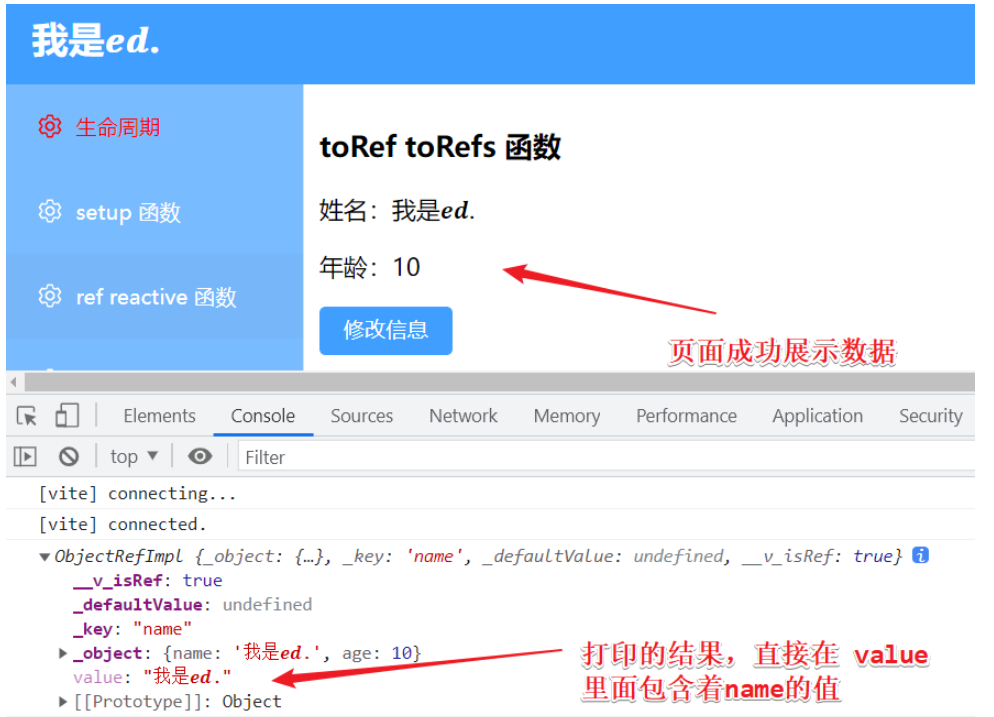
We can see the structure of the data. The value is directly the attribute value of the name under boy. So, next we write a button, click the button, and modify this name value.
<template>
<div>
<h2 id="toRef-nbsp-toRefs-nbsp-函数">toRef toRefs 函数</h2>
<p>姓名:{{boy_toRef}}</p>
<p>年龄:{{boy.age}}</p>
<el-button type="primary" @click="btn">修改 name</el-button>
</div>
</template>
<script>
import { toRef } from 'vue'
export default {
setup() {
const boy = {
name: '我是????????.',
age: 10
}
// 这个 boy_toRef 就是被 toRef 函数操作过的 boy 的 name 值
const boy_toRef = toRef(boy, 'name')
const btn = () => {
boy_toRef.value = '????????.' // 把 name 修改成 ????????.
console.log(boy_toRef) // 修改完成打印一下结果
}
return { boy, btn, boy_toRef }
}
}
</script>Save the code and refresh the page, then click the button to see the page effect.
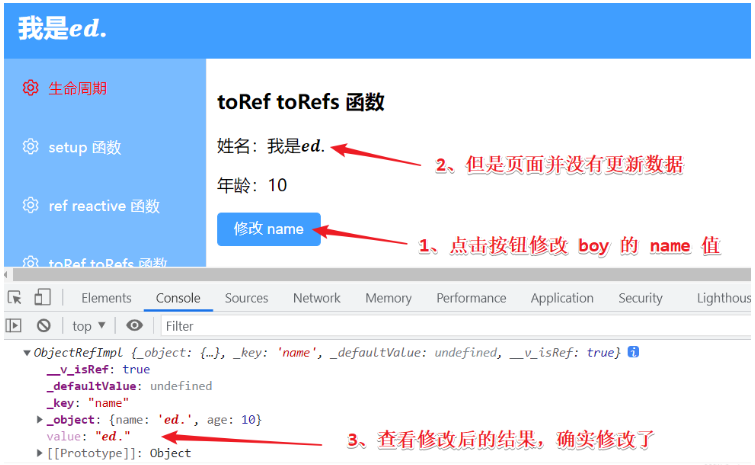
We can find from the screenshots that the value of boy_toRef has indeed been modified, but the page has not changed, and there is no error on the page.
What is the reason for this? In fact, this is not a bug. As I said at the beginning of this blog post, the toRef function will interact with the source data. Modifying the responsive data will cause the source data to be modified, but its modification will not cause the view layer data to be updated. So, This is what the toRef function does. Indeed, we can see from the screenshot above that there is no data update in the view, but what about the modification of the source data? It doesn't matter, before answering this question, we first have to know what source data is.
Just like the above code:
const boy = {
name: '我是????????.',
age: 10
}
const boy_toRef = toRef(boy, 'name')The toRef function wraps the boy object, so the boy object is the source data.
Therefore, if you want to confirm whether the original data has changed, you need to print the boy object after clicking the button and observe whether it has changed.
<template>
<div>
<h2 id="toRef-nbsp-toRefs-nbsp-函数">toRef toRefs 函数</h2>
<p>姓名:{{boy_toRef}}</p>
<p>年龄:{{boy.age}}</p>
<el-button type="primary" @click="btn">修改 name</el-button>
</div>
</template>
<script>
import { toRef } from 'vue'
export default {
setup() {
const boy = {
name: '我是????????.',
age: 10
}
const boy_toRef = toRef(boy, 'name') // 这个 boy_toRef 就是被 toRef 函数操作过的 boy 的 name 值
const btn = () => {
boy_toRef.value = '????????.' // 把 name 修改成 ????????.
console.log(boy_toRef) // 修改完成打印一下结果
console.log(boy) // 修改完成打印一下boy结果
}
return { boy, btn, boy_toRef }
}
}
</script>Save the code, refresh the page, click the button to modify the name value, and then check the boy object printed on the console.
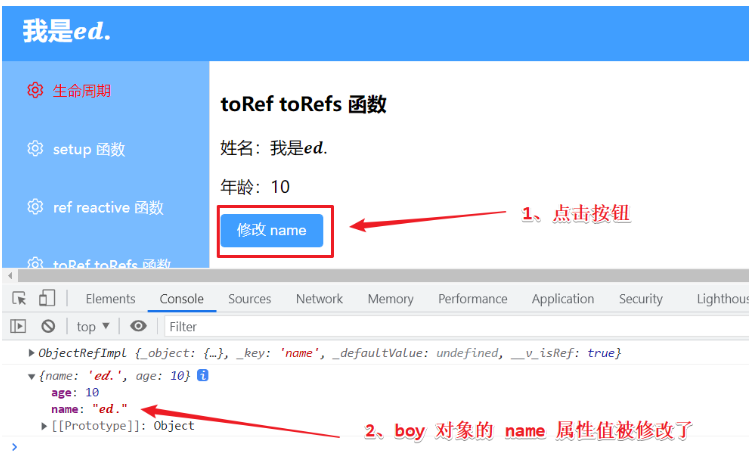
It is found that the name value of the boy object has been changed from I am ?????????. to ??????? ???., but the page is still not updated.
remember!
The toRef function will interact with the source data. Modifying the responsive data will cause the source data to be modified, but its modification will not cause the view layer data to be updated.
ref function verification
The ref function can turn the attribute values in the object into responsive data. Modifying the responsive data will not affect the source data, but the view The data on the layer will be updated. Is this correct? We didn’t test it in the previous section, so we’ll test it here too.
Let’s still write a case. The page displays a name. Click the button to modify the page name.
<template>
<div>
<h2 id="ref-nbsp-reactive-nbsp-函数">ref reactive 函数</h2>
<p>姓名:{{name_ref}}</p>
<el-button type="primary" @click="btn">修改信息</el-button>
</div>
</template>
<script>
import { ref } from 'vue'
export default {
setup() {
const name = '我是????????.'
const name_ref = ref(name)
const btn = () => {
name_ref.value = '????????.'
console.log(name_ref) // 打印一下被ref包裹的数据
console.log(name) // 打印一下源数据
}
return { name_ref, btn }
}
}
</script>Save the code, refresh the page, click the button to view the results printed by the page console, mainly to see whether the data wrapped by the ref function has been modified successfully, whether the source data has been modified successfully, and whether the final page has Modification, see screenshot below.
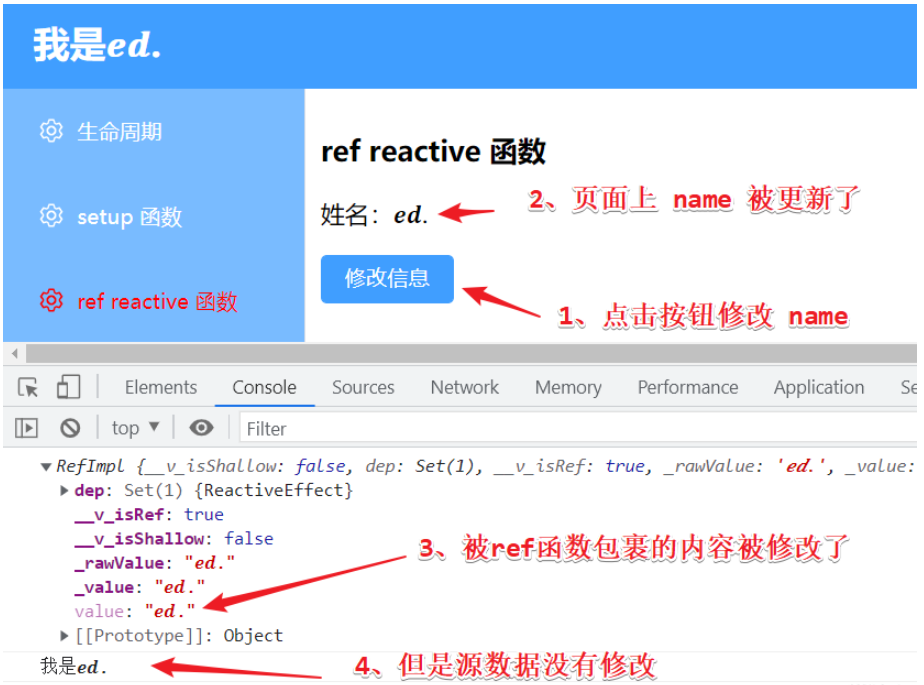
OK, through the screenshot above, everyone understands it!
So remember again!
The ref function can change the attribute value in the object into responsive data. Modifying the responsive data will not affect the source data, but the data on the view layer will be updated
toRefs function
The use of toRefs function is actually similar to the toRef function.
The toRefs function is used to set multiple data to corresponding data in batches.
The toRefs function interacts with the original data. Modifying the responsive data will affect the source data, but will not update the view layer.
The toRefs function can also interact with other responsive data, making it easier to process view layer data.
toRefs function uses the old
method to create an object, then wrap it with the toRefs function and display it on the page.
<template>
<div>
<h2 id="toRef-nbsp-toRefs-nbsp-函数">toRef toRefs 函数</h2>
<p>姓名:{{boy_toRefs.name}}</p>
<p>年龄:{{boy_toRefs.age}}</p>
</div>
</template>
<script>
import { toRefs } from 'vue'
export default {
setup() {
const boy = {
name: '我是????????.',
age: 10
}
const boy_toRefs = toRefs(boy) // 将 boy 用 toRefs 包裹
console.log(boy_toRefs) // 打印一下结果
return { boy_toRefs }
}
}
</script>Save the code and refresh the page to view.
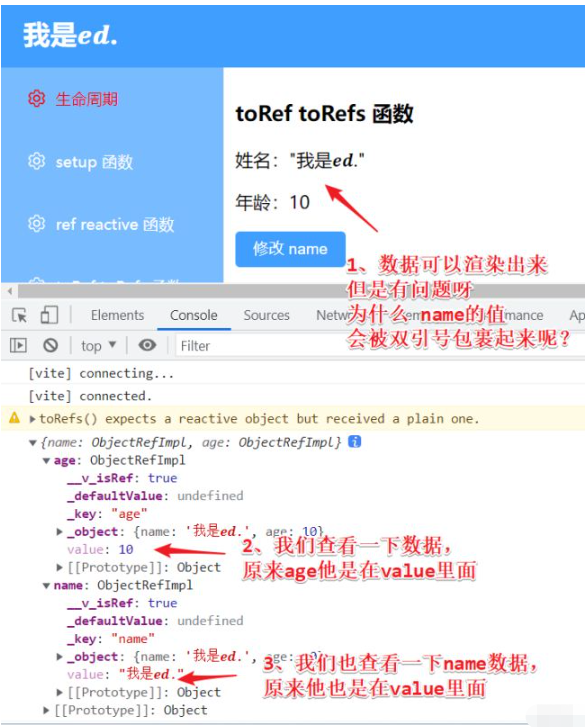
So, let’s modify the code. In addition to .property, we also need .value during rendering.
<p>姓名:{{boy_toRefs.name.value}}</p>
<p>年龄:{{boy_toRefs.age.value}}</p>Modify the view layer code and check the effect.
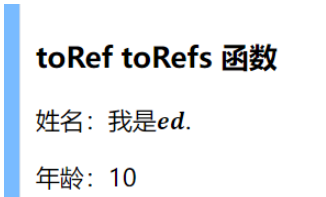
Hey, it’s normal now!
Some people may wonder, isn't this thing getting more and more complicated? Originally, you could just click on the attribute, but now you have to click on the attribute and value. Isn't it unnecessary to take off your pants and put P on it? Hey hey hey! I think so too.
Why is it normal to say that it is unnecessary, because as mentioned in the previous blog post, we can use the reactive function to process this kind of complex structure data. Rendering can be done by clicking once at most, but the toRefs function requires a few clicks. twice.
<template>
<div>
<h2 id="toRef-nbsp-toRefs-nbsp-函数">toRef toRefs 函数</h2>
<p>姓名:{{boy_toRefs.name}}</p>
<p>年龄:{{boy_toRefs.age}}</p>
</div>
</template>
<script>
import { toRefs, reactive } from 'vue'
export default {
setup() {
const boy = {
name: '我是????????.',
age: 10
}
const boy_toRefs = reactive(boy)
return { boy_toRefs }
}
}
</script>我们不使用 toRefs 函数,而是用之前说的 reactive 函数处理数据。
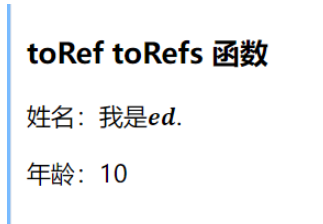
我们可以看到,页面是可以正常解析的,那为什么我们还有舍近求远的使用 toRefs 函数呢?
其实是有原因的呀!
其实 toRefs 函数最大的用处在这里!
我们这个 boy 对象里面只有两个参数比较少,如果我们这个对象里面有十个参数或者是更多的话,每次展示的时候都得写那么多遍的 boy 点,是不是很麻烦呢?所以说使用 toRefs 函数就可以解决这个问题,看下面的代码。
<template>
<div>
<h2 id="toRef-nbsp-toRefs-nbsp-函数">toRef toRefs 函数</h2>
<p>姓名:{{name}}</p>
<p>年龄:{{age}}</p>
</div>
</template>
<script>
import { toRefs } from 'vue'
export default {
setup() {
const boy = {
name: '我是????????.',
age: 10
}
return { boy_toRefs , ...toRefs(boy)}
}
}
</script>在 return 抛出 reactive 的时候,使用扩展运算符和 toRefs 函数,就可以实现直接写属性的方式展示数据了。
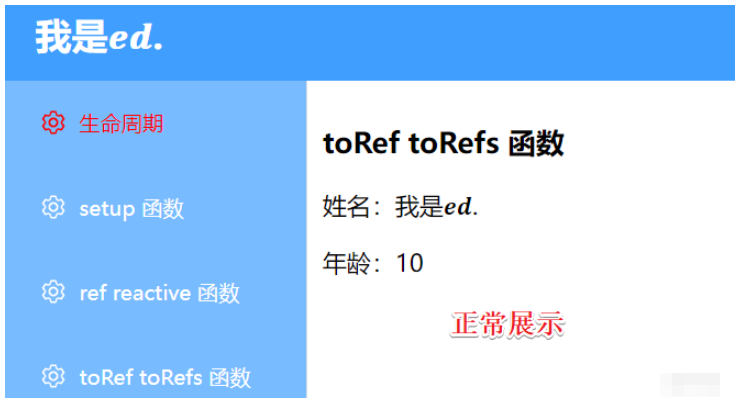
但是呢,深层次的对象依旧需要通过点来实现。
也许你还有疑问,直接扩展运算 reactive 函数也行啊,为啥要套上 toRefs 函数,记住一点呀!
toRefs 函数修改,原始数据被改变,页面不会被触发。
看下面代码:
<template>
<div>
<h2 id="toRef-nbsp-toRefs-nbsp-函数">toRef toRefs 函数</h2>
<p>姓名:{{name}}</p>
<p>年龄:{{age}}</p>
<el-button type="primary" @click="btn">修改 name</el-button>
</div>
</template>
<script>
import { toRefs, reactive } from 'vue'
export default {
setup() {
const boy = {
name: '我是????????.',
age: 10
}
const new_toRefs = toRefs(boy)
const btn = () => {
new_toRefs.name.value = '????????.'
console.log(boy)
}
return { btn, ...toRefs(boy) }
}
}
</script>打印一下结果:
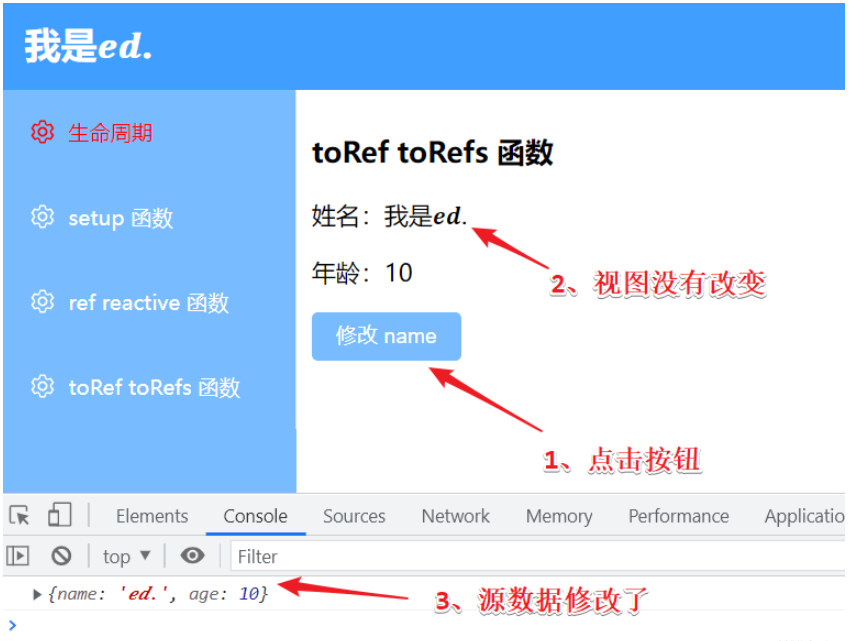
从打印结果中可以看出,原始数据被改变,页面没有被触发。根据我的写法,可以发现,从解构或构建 toRefs 返回的对象,都不会对值的响应性产生影响。
The above is the detailed content of How to use toRef and toRefs functions in Vue3. For more information, please follow other related articles on the PHP Chinese website!

Hot AI Tools

Undresser.AI Undress
AI-powered app for creating realistic nude photos

AI Clothes Remover
Online AI tool for removing clothes from photos.

Undress AI Tool
Undress images for free

Clothoff.io
AI clothes remover

AI Hentai Generator
Generate AI Hentai for free.

Hot Article

Hot Tools

Notepad++7.3.1
Easy-to-use and free code editor

SublimeText3 Chinese version
Chinese version, very easy to use

Zend Studio 13.0.1
Powerful PHP integrated development environment

Dreamweaver CS6
Visual web development tools

SublimeText3 Mac version
God-level code editing software (SublimeText3)

Hot Topics
 1378
1378
 52
52
 vue3+vite: How to solve the error when using require to dynamically import images in src
May 21, 2023 pm 03:16 PM
vue3+vite: How to solve the error when using require to dynamically import images in src
May 21, 2023 pm 03:16 PM
vue3+vite:src uses require to dynamically import images and error reports and solutions. vue3+vite dynamically imports multiple images. If vue3 is using typescript development, require will introduce image errors. requireisnotdefined cannot be used like vue2 such as imgUrl:require(' .../assets/test.png') is imported because typescript does not support require, so import is used. Here is how to solve it: use awaitimport
 How to use tinymce in vue3 project
May 19, 2023 pm 08:40 PM
How to use tinymce in vue3 project
May 19, 2023 pm 08:40 PM
tinymce is a fully functional rich text editor plug-in, but introducing tinymce into vue is not as smooth as other Vue rich text plug-ins. tinymce itself is not suitable for Vue, and @tinymce/tinymce-vue needs to be introduced, and It is a foreign rich text plug-in and has not passed the Chinese version. You need to download the translation package from its official website (you may need to bypass the firewall). 1. Install related dependencies npminstalltinymce-Snpminstall@tinymce/tinymce-vue-S2. Download the Chinese package 3. Introduce the skin and Chinese package. Create a new tinymce folder in the project public folder and download the
 How Vue3 parses markdown and implements code highlighting
May 20, 2023 pm 04:16 PM
How Vue3 parses markdown and implements code highlighting
May 20, 2023 pm 04:16 PM
Vue implements the blog front-end and needs to implement markdown parsing. If there is code, it needs to implement code highlighting. There are many markdown parsing libraries for Vue, such as markdown-it, vue-markdown-loader, marked, vue-markdown, etc. These libraries are all very similar. Marked is used here, and highlight.js is used as the code highlighting library. The specific implementation steps are as follows: 1. Install dependent libraries. Open the command window under the vue project and enter the following command npminstallmarked-save//marked to convert markdown into htmlnpmins
 How to refresh partial content of the page in Vue3
May 26, 2023 pm 05:31 PM
How to refresh partial content of the page in Vue3
May 26, 2023 pm 05:31 PM
To achieve partial refresh of the page, we only need to implement the re-rendering of the local component (dom). In Vue, the easiest way to achieve this effect is to use the v-if directive. In Vue2, in addition to using the v-if instruction to re-render the local dom, we can also create a new blank component. When we need to refresh the local page, jump to this blank component page, and then jump back in the beforeRouteEnter guard in the blank component. original page. As shown in the figure below, how to click the refresh button in Vue3.X to reload the DOM within the red box and display the corresponding loading status. Since the guard in the component in the scriptsetup syntax in Vue3.X only has o
 How to solve the problem that after the vue3 project is packaged and published to the server, the access page displays blank
May 17, 2023 am 08:19 AM
How to solve the problem that after the vue3 project is packaged and published to the server, the access page displays blank
May 17, 2023 am 08:19 AM
After the vue3 project is packaged and published to the server, the access page displays blank 1. The publicPath in the vue.config.js file is processed as follows: const{defineConfig}=require('@vue/cli-service') module.exports=defineConfig({publicPath :process.env.NODE_ENV==='production'?'./':'/&
 How to select an avatar and crop it in Vue3
May 29, 2023 am 10:22 AM
How to select an avatar and crop it in Vue3
May 29, 2023 am 10:22 AM
The final effect is to install the VueCropper component yarnaddvue-cropper@next. The above installation value is for Vue3. If it is Vue2 or you want to use other methods to reference, please visit its official npm address: official tutorial. It is also very simple to reference and use it in a component. You only need to introduce the corresponding component and its style file. I do not reference it globally here, but only introduce import{userInfoByRequest}from'../js/api' in my component file. import{VueCropper}from'vue-cropper&
 How to use Vue3 reusable components
May 20, 2023 pm 07:25 PM
How to use Vue3 reusable components
May 20, 2023 pm 07:25 PM
Preface Whether it is vue or react, when we encounter multiple repeated codes, we will think about how to reuse these codes instead of filling a file with a bunch of redundant codes. In fact, both vue and react can achieve reuse by extracting components, but if you encounter some small code fragments and you don’t want to extract another file, in comparison, react can be used in the same Declare the corresponding widget in the file, or implement it through renderfunction, such as: constDemo:FC=({msg})=>{returndemomsgis{msg}}constApp:FC=()=>{return(
 How to use defineCustomElement to define components in Vue3
May 28, 2023 am 11:29 AM
How to use defineCustomElement to define components in Vue3
May 28, 2023 am 11:29 AM
Using Vue to build custom elements WebComponents is a collective name for a set of web native APIs that allow developers to create reusable custom elements (customelements). The main benefit of custom elements is that they can be used with any framework, even without one. They are ideal when you are targeting end users who may be using a different front-end technology stack, or when you want to decouple the final application from the implementation details of the components it uses. Vue and WebComponents are complementary technologies, and Vue provides excellent support for using and creating custom elements. You can integrate custom elements into existing Vue applications, or use Vue to build




